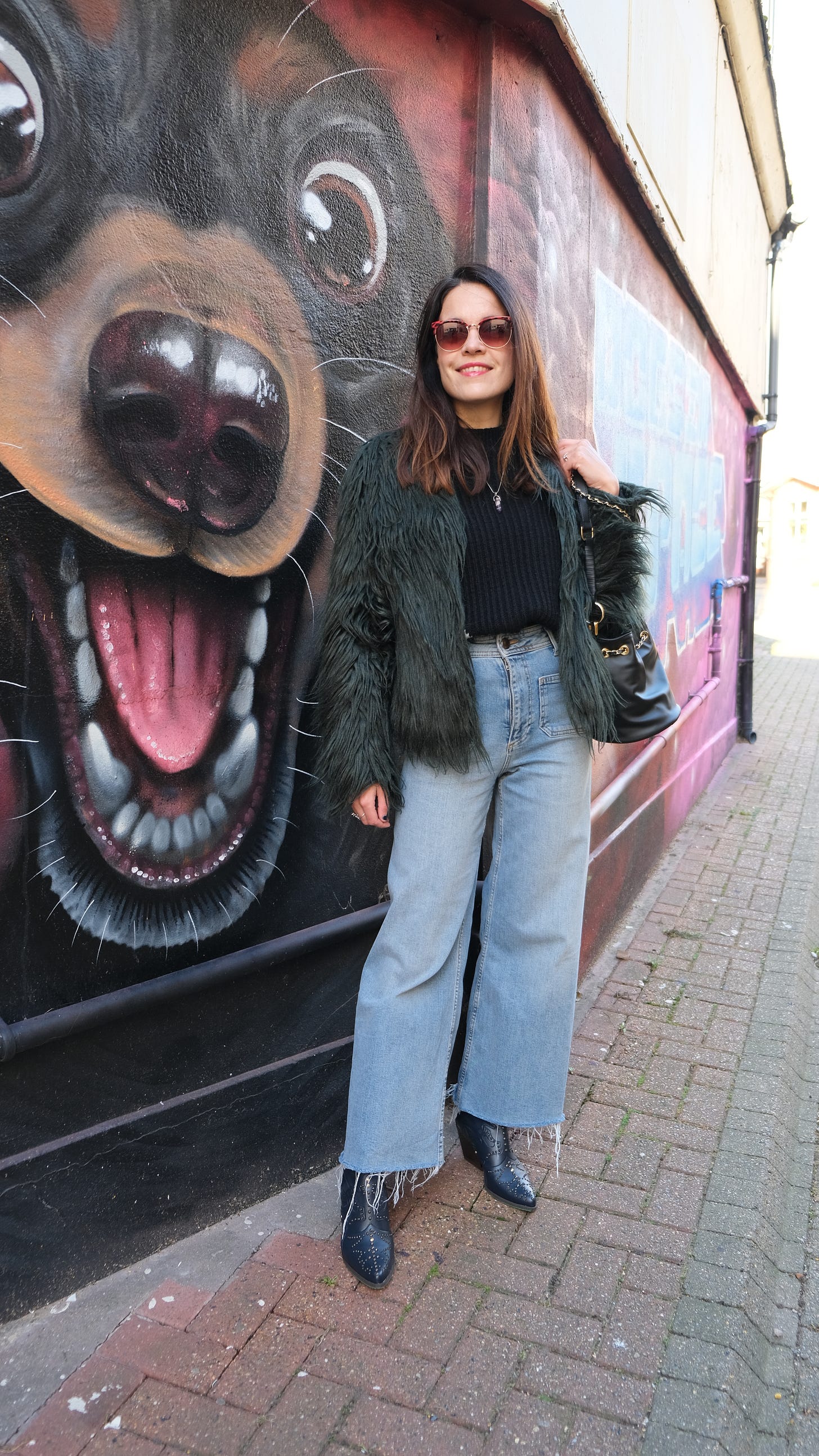No But Seriously: Is It Ever Okay to Wear Second-Hand Fur?
Disclaimer: ALL the fur in this post is FAUX
So, my fellow fashion people (and former fashion people, I won’t pretend like I didn’t run away from that industry like Anna Wintour herself was chasing me), I’m sure that we’ve all seen the headlines: over the last couple of seasons, fashion media cannot stop screaming that “fur is back”. Apparently, years after the fashion world coming to the long-overdue collective realisation that skinning animals for overpriced jackets is in fact disgusting, the style set has changed their mind right back. All of a sudden, it’s cool to wear dead mink again! Everyone wants to walk around draped in a fox who lived their short life in a wire cage where they could barely turn around. Did you miss the memo? Fur is all the rage.
Or…is it?

Let’s get the important stuff out of the way first: fur is not back in fashion. This is an industry narrative designed to bring it back through re-raising its public perception. I have talked about this before, and I’ll keep shouting it from the rooftops until we are done with this nonsense:
Nearly all designers mentioned in every “fur is back” article are, in fact, fur-free and showed faux fur on their runways during the most recent season. Aside from hardcore furriers like Fendi (and even those brands have shown interest in vegan material innovation), fashion remains largely fur-free. All designers who banned fur a few years ago retain their fur-free policies, and the fur industry is in drastic decline.
The fur that is claimed to be “back”, though, is vintage fur. Through a rise in secondhand fashion and a long-awaited return to maximalism (we all got sick of quiet luxury, didn’t we?), your grandma’s smelly old chinchilla coat is now the kind of thing Kendall Jenner would wear. Let me say it once again and no, I don’t mind sounding like a broken record, vintage fur does not represent an upswing for the actual fur industry. It is as dead as ever. But the question is, how do we feel about wearing those old secondhand furs? Is it defensible by the fact that it’s “already out there”? Is it kinder to the planet? Is it, after all, a little bit okay?
I’ll go first: never. Never in my life will I ever wear something that caused this level of terror, pain, and death. It doesn’t matter whether the animal died last month or fifty years ago. They still had an absolutely horrifying life and an even worse death. Plus, like often happens with many animal-derived materials, speciesism is a play: ask yourself if we as a society would find dog or cat fur acceptable just because it was made thirty years ago?
Emma Håkansson is the founder of fashion activism organisation Collective Fashion Justice and the author of the book Total Ethics Fashion (listen to my interview with Emma on my podcast here). When VOGUE asked her about secondhand fur, she brought up thought-provoking points:
“The ethics of wearing vintage fur can be made more clear when we think of other species previously commodified by fashion, and no longer acceptably so: whale-skin bags, dog-fur coats. If we would feel uncomfortable wearing these vintage items, why not also a mink or fox?”
Emma brings the message that an animal’s body belongs to them, not us - no matter which animal, and how long ago the violence happened. When I posed the question on my Instagram, the replies were unanimous:
I couldn’t ever. It bothers me too much.
No, it is still sending the message that it is okay to wear fur.
No, I would never wear someone else’s skin.
Someone was a bit more forgiving:
No, but I don’t mind if others do.
Granted, my following is mostly vegans and other consciously minded people. But there is no escaping the fact that admitting to wearing fur, vintage or not, still makes most people recoil. Even those parading vintage coats on the streets often low-key feel like there is an element of shame, which is clear from some of the articles that interview vintage fur-wearers. Their immediately defensive stance, which often comes through in their repeating how not defensive they feel about it (“I don’t feel bad about it! It’s vintage!” - hmmm okay Poppy-Lee, 23, from Dalston, whatever you say) makes it evident that no, wearing fur has not become socially acceptable again. This also shows when celebrities are pelted with criticism (see what I did there?) whenever they step out in any kind of fur.
Arnaud Brunois, of French faux-fur artisan house Ecopel, was recently interviewed by GRAZIA on this - and he brought up a point I hadn’t previously considered:
“If fur factory farms still operate today, it means that the fur of animals killed today may be sold as vintage fur in one or two decades. It just becomes a new business opportunity for the industry and, at the end, animals are still being exploited.”
Read that again.
If we accept vintage fur, we have to keep creating it. Hence, the only way for vintage fur to be okay is if we close down all new fur farming. Which I believe we are all in favour of doing anyway, but we’re hardly there yet.
Let us now address the claim that “vintage fur is better than plastic.” If we are speaking about buying a vintage coat versus buying a brand-new faux fur, then sure, whatever is already out there is environmentally preferable. But why are we choosing between these two options? There are, of course, more choices than succumbing to grandma’s moth-eaten coat or pulling on a petroleum jacket.
Options preferable to wearing any kind of animal fur:
Not wearing any fur at all. Guess what, there are tons of other lovely things to wear. Coats made from recycled materials and organic cotton. High-tech puffer jackets with recycled vegan fillers. In most places in the world and most contexts, fur is not a must.
Wearing second-hand vegan furs. They are also “already here” and no animals died for them.
Wearing bio-based furs. Completely free from plastic, these are also made without any animal involvement.
Granted, this last option isn’t widely available on the market yet. But we’re getting there! French faux fur artisans Ecopel have led the way in creating Flur, a fully plant-based, plastic-free vegan fur. And they’re not the only ones: Ganni have made an iteration of their Bou bag with BioFluff, a vegan fur made from hemp, flax, and nettles. Fur made from nettles! What a time to be alive.
Having said all of this, I don’t necessarily think badly of those who choose to wear the fur they owned before going vegan, or before changing their minds about fur. Because if I did, I’d have to change my stance on wearing your old leather, wool and down garments - which I believe is okay to do. In the end, fur is no different from those materials. The pain and terror behind them is the same. The environmental destruction behind them is similar. The communities, human and animal, devastated by them suffered in the same ways. If we accept vintage leather, we must also accept vintage fur. This is why I won’t wear either. But, as there is little else we can do with the clothes we have already produced, I won’t judge anyone who does.
Actually, there is indeed something you can do if you have a fur coat that you feel iffy about wearing. You can donate it PETA! That’s right, the animal rights group runs a fur donation programme where people who have changed their minds about wearing fur can send their old coats. The garments end up used in educational displays, given to animal shelters as bedding, or donated to refugees or homeless people - who, let’s face it, are the only ones with an excuse to wear fur.
In the end, what matters is, as I’ve said before, how we view animals. Are we still justifying ways to exploit them? Are we thinking up far-fetched reasons why it’s okay to objectify them? Would you wear a vintage dog-skin jacket? Sit with those questions for a while, and if you decide you want to reach for that vintage fur coat, I won’t judge you. But I won’t join you, either.






From the 1970s, when Animal Activists and I protested outside Harrods and their fur shop to the present, the fur trade has repeatedly claimed, so often (every few years?), that Fur is Back. Their cry no longer carries any true meaning, however. The evidence that fur is not back and is clearly in decline in the fur trade in the UK is with the widespread closure of fur shops and the lack of fur being worn by people on the streets. Yes, the remains of the fur trade persist, more strongly in some countries than others, but it is a matter of time and perseverance on our part that the fur trade will become uneconomically viable and culturally taboo.
Tricky and interesting subject